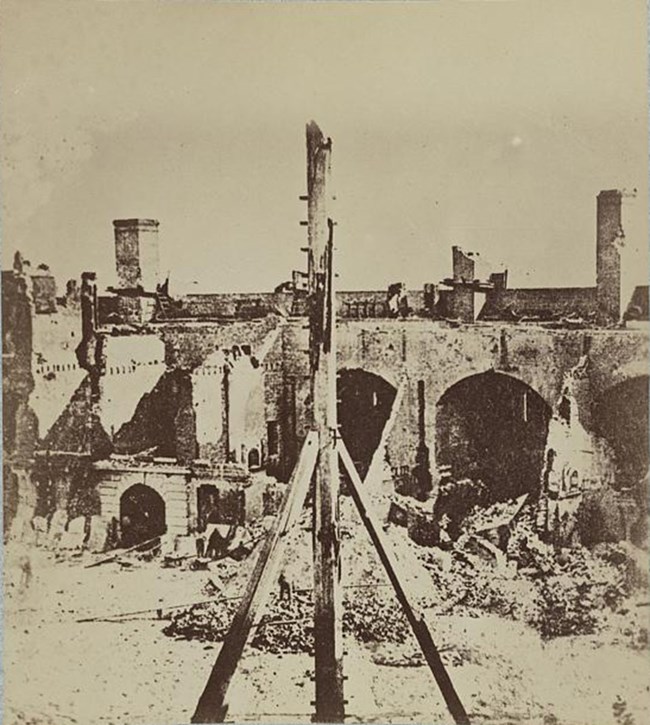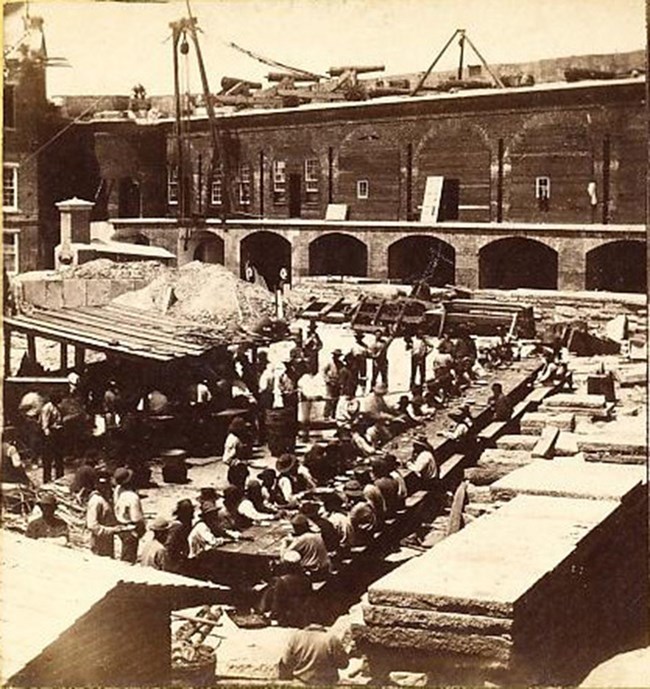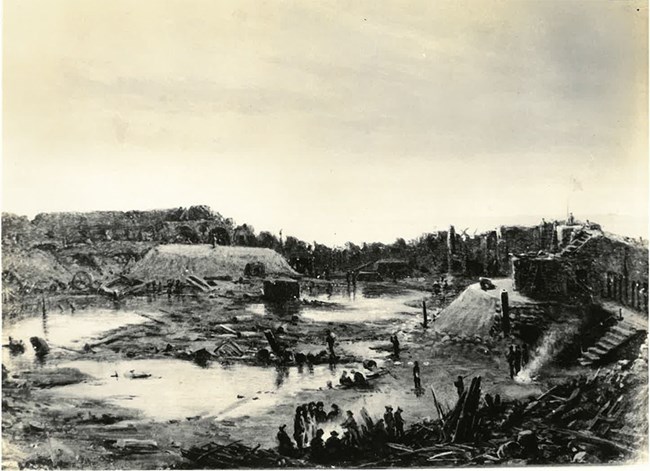What Year Was Fort Sumter Repaired Following The War?

Library of Congress
Post-obit the evacuation of Major Robert Anderson and his Federal garrison on the afternoon of April 14, 1861, Fort Sumter was occupied initially by Confederate troops of Visitor B of the 1st South Carolina Artillery Battalion and a volunteer company of the Palmetto Guard, a local militia unit. The fort remained in Confederate hands for the side by side four years until all Confederate forces evacuated Charleston during the evening of February 17, 1865.
During the starting time two years of Confederate occupation of Fort Sumter, the war raged on other battlefields. Life at Fort Sumter was relatively good despite some dissention and a feud between senior officers that ended in two duels. However, on Apr seven, 1863, the war came over again to Fort Sumter with an assault by nine Wedlock Navy ironclads, and life in the fort over the side by side two years inverse dramatically.
Conditions at Fort Sumter upon Confederate Occupation
When Confederate troops marched into the fort on the afternoon of April 14, 1861, over 3,300 shells and "hot shot" had been fired at the fort during the initial 34-60 minutes bombardment by 43 Amalgamated guns. The terreplein (height level) was a wreck, and the parade ground was pitted with crush craters. The enlisted barracks were gutted from fires still burning. The officer quarters were a butchery. However, the outer walls were not damaged significantly.
Repairs and Improvements
The soldiers, along with civilian and enslaved laborers, immediately got to work extinguishing fires and repairing impairment. Over the next weeks and months, work centered on restoring buildings, casemates, and magazines. Additional cannons and mortars were mounted bringing the total to 92, and other improvements were made including:
• Structures – The incomplete embrasures (or gun ports) on the upper casemates were bricked in (except for three on the salient) leaving only narrow loopholes for small arms fire. Harm from shells was repaired. Burned out barracks were partially rebuilt but to a lower level, the magazines were strengthened, and the two hot shot furnaces restored.
• Communications – A telegraphic connection was established with Amalgamated headquarters by way of James Island. A submerged telegraphic cablevision (or submarine cable) was also completed betwixt Sumter and Fort Moultrie.
• Food Supply – Fresh produce, meats, and other appurtenances were brought from the urban center past gunkhole to supplement the normal rations of bacon, pork, flour, rice, and repast. A bakery was supplied and was said to have used the ii hot shot furnaces.
• H2o Supply – The drainage organisation to collect rainwater to feed the 5 cisterns (totaling some 25,100 gallons) was repaired. A machine for converting salt water into fresh h2o by distilling the salt h2o in a boiler was provided to supplement the cisterns. Water was also transported from the city by boat.
• Lighting – Candles and oil lamps were certainly a master source of calorie-free. Yet, a major improvement to the fort was a gas-works that supplied gas lighting to several places within the fort. The remnants of a gas line can be seen in the wall virtually the magazine. The gas-works was most probable of the blazon used on local plantations to vaporize pino rosin, so pressurize the vapors (or gas) to strength feed the supply lines to the light fixtures.
• Other improvements included a forge for metalworking, a shoe factory, and a fire engine.

Keith Brady Collection
Daily Life 1861 - 63
While the fort was designed to house 650 officers and soldiers, somewhere betwixt 300 and 550 Confederates manned the fort during the first two years of the war. Garrison life was relatively peaceful and routine. Initially, the arming of more cannons plus the repair and comeback work consumed part of their fourth dimension fifty-fifty though the heavy labor was conducted by work crews comprised largely of enslaved people from local plantations. Training in gunnery, military drills, and other defensive measures were the mainstay of the soldiers' work days.
Entertainment was limited. Social life was restricted to off-duty soldier pastimes, such as letter writing, board and menu games, music, and storytelling. Leave passes to the urban center and occasional visits to home were highly sought afterwards. A highlight was weekend visits past citizens to include ladies bringing picnics and offering chat and a change from the drudgery of grooming and daily garrison life.

Keith Brady Drove
Battery 1863 - 65
On April seven, 1863, the war returned to Charleston Harbor when the United states of america Navy, with a armada of 9 ironclads, attacked Fort Sumter. While the set on was repelled, and the damage from this two and one-half 60 minutes engagement was light, it was a wake-up telephone call.
Following this set on, preparations were immediately undertaken to strengthen the fort against further attack by heavier and longer range Marriage arms. Between the ironclad attack in April and the first battery in Baronial, these efforts were intense, with as many as 450 mechanics and laborers engaged. The upper and lower casemates of the right flank (or sea wall) and the upper and lower rooms of the gorge wall were filled with sand and wetted cotton fiber bales. These reinforcement efforts also included the building of bombproofs (or bomb shelters) and, later, communication tunnels. While droppings from the shelling played a role in the ongoing strengthening efforts, new materials hauled in dark after dark constituted the majority of the repair and reinforcement.
Repairs continued on a daily footing throughout the 18-month Marriage bombardment, which began on August 12, 1863. From August 1863 to February 1865, there were three major and viii pocket-sized bombardments from US Army artillery located on Morris Island and the US Navy occludent fleet. The fort was nether direct burn a total of 280 days during that 18-month timeframe. Information technology was to exist the longest siege under fire in US armed forces history. Over 46,000 projectiles were fired confronting it with an estimated total weight in metallic of 3,500 tons.
Amalgamated soldiers suffered at least 52 killed and 267 wounded. The exact number of civilian and enslaved casualties was not advisedly documented and thus remains unknown, although undoubtedly significant and thought to exist roughly proportionate to the soldier casualties.
Life Under Fire
Following the first heavy bombardment in August 1863, cannons and pulverisation were removed from the fort and deployed elsewhere in the harbor to avoid destruction. The size of the garrison shrunk to a daily average of almost 350 soldiers and 150 enslaved people. Infantry soldiers replaced artillery soldiers. Life in the fort had get a living hell. In addition to the stress and danger of exposure to exploding shells and the chilly, dark, stifling atmosphere of the bombproofs, the quality and quantity of nutrient and h2o deteriorated, and disease began to appear. While supplies were ferried to the fort by gunkhole each night and the soldiers and slaves were rotated regularly from the fort to provide some relief, the earlier days of peaceful garrison life were gone. It was at present a instance of survival.
Significance
Despite the determined efforts of United states Army and Navy gunners, the fort, while heavily damaged, was gradually transformed into a powerful earthwork that kept Matrimony forces from penetrating the harbor defenses and capturing Charleston. With the decision of the defenders and the labor of enslaved people similar Jacob Stroyer, the Confederates held on, refusing to give up their prize of the first battle of the state of war, a symbol of southern secession. On the evening of February 17, 1865, the Fort Sumter garrison along with all remaining Amalgamated forces in the Charleston area evacuated due north to avoid existence cut off past Matrimony Full general William T Sherman's advancing army, thus ending the longest siege under fire in US military history.
What Year Was Fort Sumter Repaired Following The War?,
Source: https://www.nps.gov/articles/confederate-occupation-of-fort-sumter.htm
Posted by: stellateps1959.blogspot.com


0 Response to "What Year Was Fort Sumter Repaired Following The War?"
Post a Comment